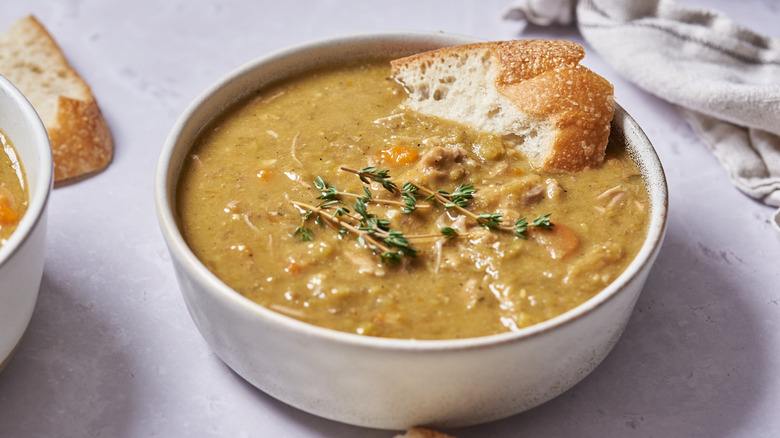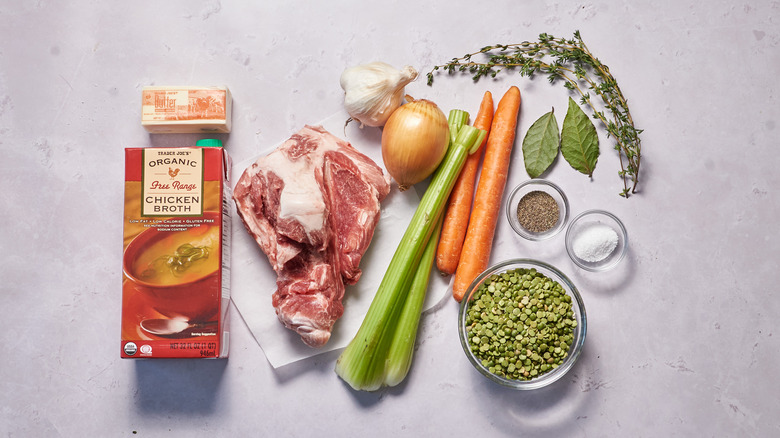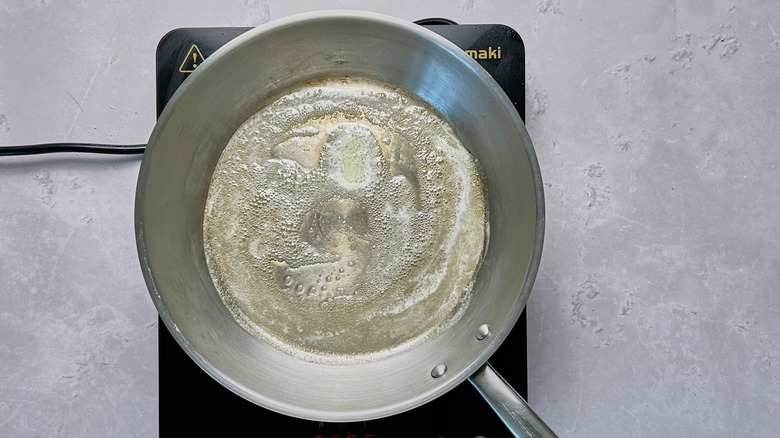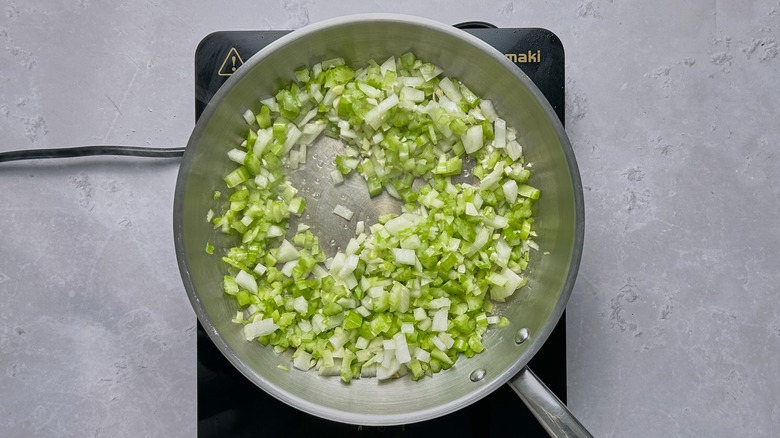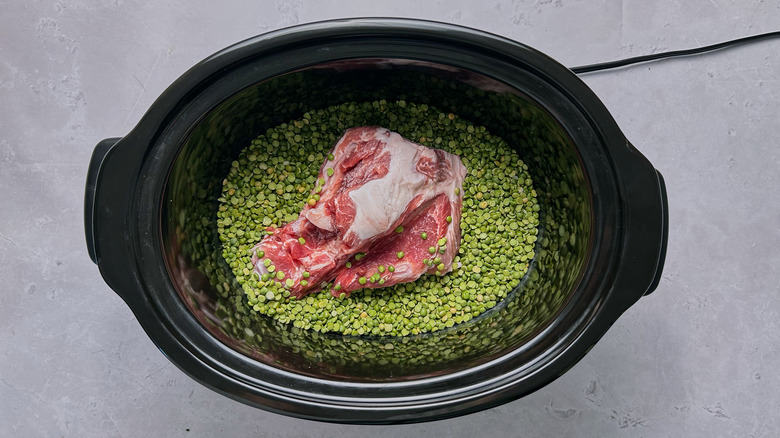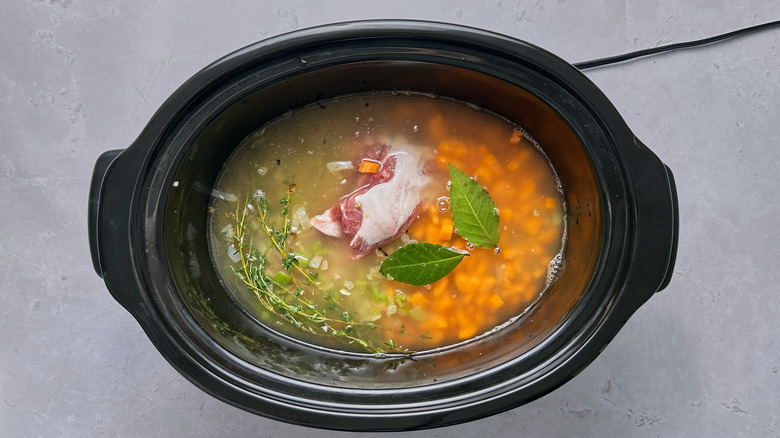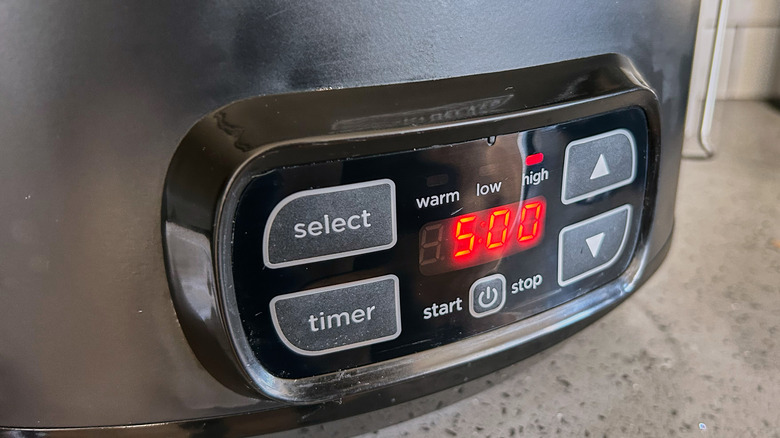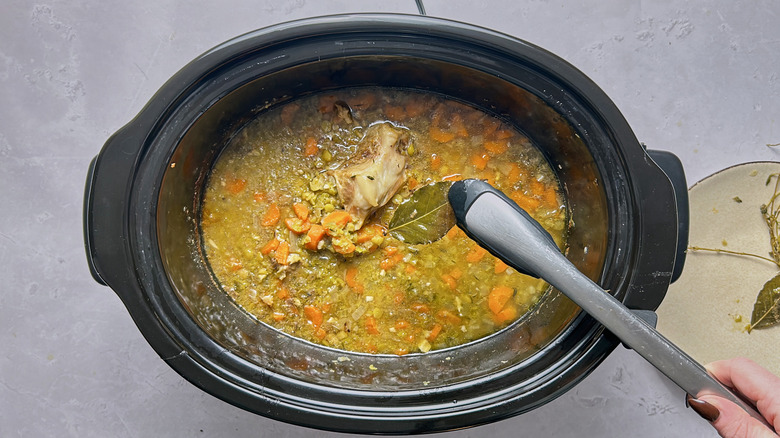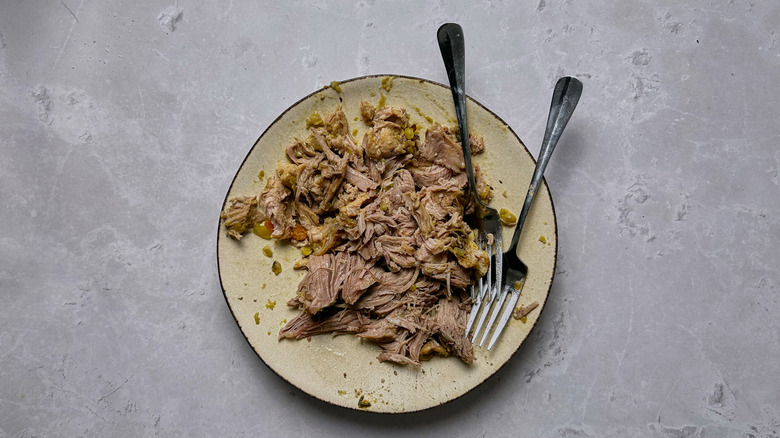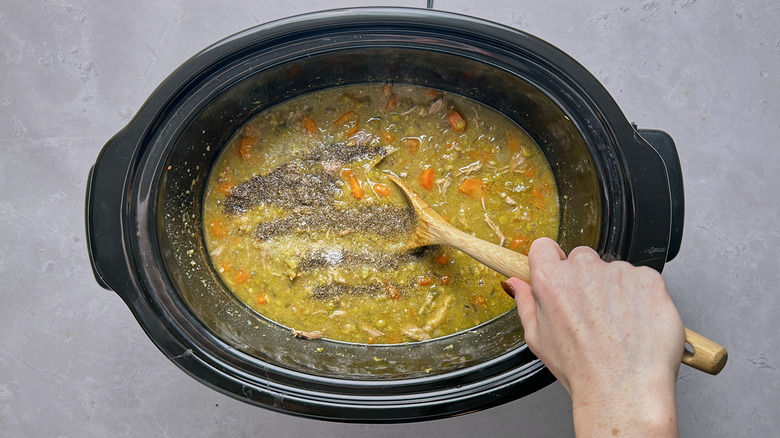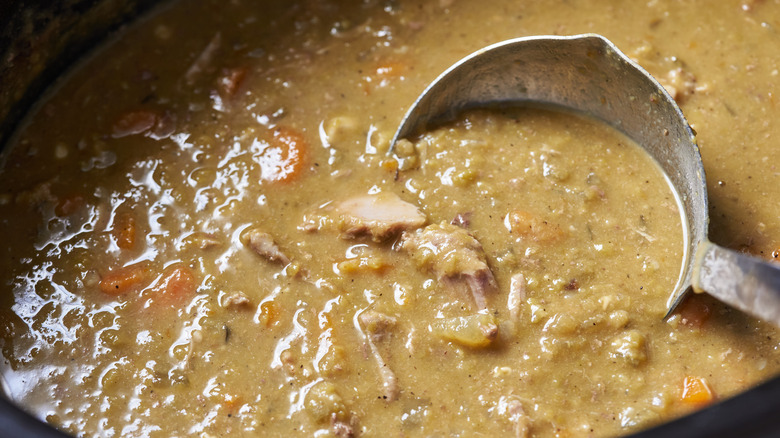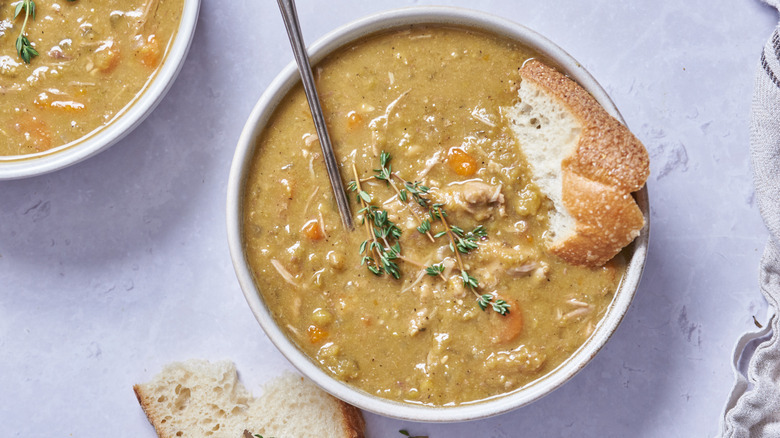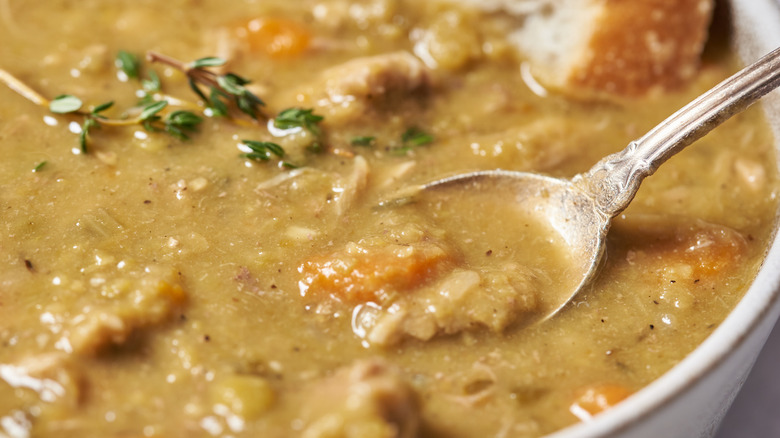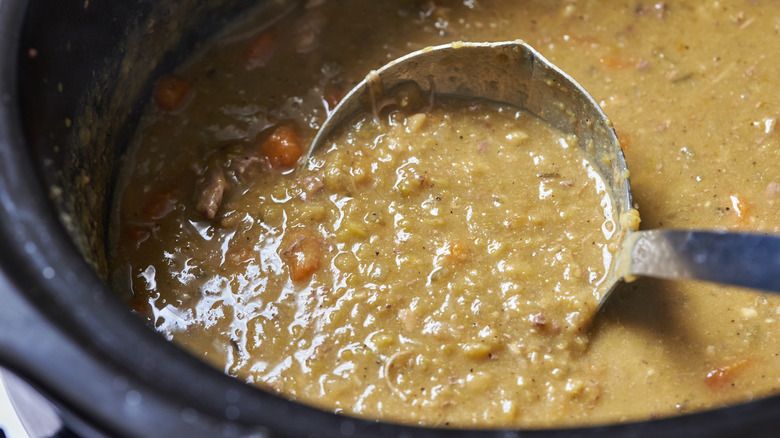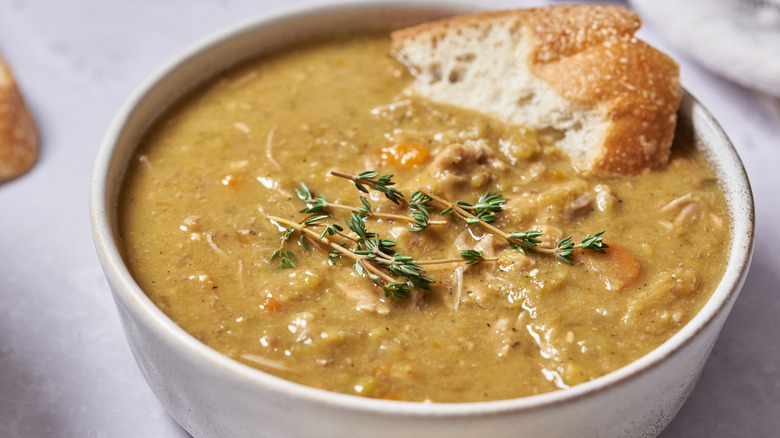Chunky Slow Cooker Split Pea Soup Recipe
Split pea soup is exactly what it sounds like and, probably, exactly what you're imagining. It's a soup made with split peas, which are small dried peas that look a lot like lentils. Split peas aren't actually lentils, though the two are very similar and can be used in the same way. For soup, the hard split pea shells must be cooked until creamy and tender, which can take hours in hot broth. The slow cooker makes this easier. Being a low, slow heat, the slow cooker makes split pea soup effortless (and almost magical) by transforming the tough-looking legumes into meltingly smooth soup.
While the peas might be the main character of the dish, the soup gets its flavor from its supporting actor. Pork and turkey bones have long been used to flavor earthy, rich dishes like greens and beans, and split pea soup is an ideal vessel for this technique. The bones add a deep, salty flavor and tender shreds of meat that turn otherwise flavorless peas into a rich and creamy soup. In this recipe, developer Michelle McGlinn walks through using pork neck bones and your slow cooker to make a perfect split pea soup.
Gather the ingredients for slow cooker split pea soup
First, you'll need split peas. Split peas can be either green or yellow. While you can use yellow split peas for this soup, green are usually recommended for their sweeter, richer flavor and because they have the "pea" flavor you'd expect, whereas yellow peas taste closer to lentils. Once you have your peas figured out, grab butter, onion, garlic, celery, carrots, bay leaves, thyme, and either chicken or vegetable broth. Then, look for pork neck bones. A little bit goes a long way with bones, so you'll only need 1 or 2 pounds to develop great flavor. Lastly, grab a little salt and pepper to season as needed.
Step 1: Melt the butter
Melt butter in a saucepan over medium heat.
Step 2: Soften the aromatics
Add the onion, celery, and garlic and saute until softened, about 3–4 minutes.
Step 3: Add the peas and pork to the slow cooker
Add split peas and pork bones to a slow cooker.
Step 4: Add the remaining ingredients
Add the softened vegetables, bay leaves, thyme, carrots, and broth to the slow cooker.
Step 5: Cook
Cook on low for 8–9 hours or high for 5–6.
Step 6: Remove the inedible parts
Remove the thyme sprigs, bay leaves, and pork bones from the slow cooker.
Step 7: Shred the pork
Shred the pork from the bone and return the meat to the soup.
Step 8: Season and serve
Season with salt and pepper to taste, then serve.
What other meats can you use in slow cooker split pea soup?
Pork neck bones are surprisingly easy to find — once you start looking for them, you'll notice them everywhere. That's because they freeze well and are great for adding flavor to dishes, and butchers are happy to sell the otherwise useless parts of their supply. If you can't find them or simply want to avoid pork, there are plenty of other options, too. You can use a bone-in pork shoulder for an extra-meaty pea soup. You can use smoked ham hock, which will offer a similarly deep flavor as the neck bones. You could swap for turkey and use turkey legs or necks; this is especially useful after Thanksgiving. You can also skip the bones and use leftover meats like shredded turkey, rotisserie chicken, or roasted ham. If using leftover meats instead of bones, adjust the salt and pepper as needed so that the soup is still rich and full of flavor.
How do you make split pea soup on the stovetop?
The slow cooker is a great option for split pea soup because it allows you to go about your day without having to tend to an open flame. However, the soup can easily be made on the stovetop, as well. When switching recipes to the stovetop, consider the heat source. The slow cooker is heated low, slow, and covered, creating a basin of steam that keeps the liquid intact. On the stove, the heat is more direct, heating the pot and evaporating the liquid. To make split pea soup on the stovetop, prepare as directed, sauteeing the vegetables directly in the stockpot. Add the split peas, pork, the broth, and the seasonings, and bring to a simmer. Lower the heat as much as possible, cover, then simmer for 2–3 hours, checking every hour to replenish any evaporated liquid. The soup should thicken but should not absorb all of the liquid or stick to the bottom. Once the pork shreds easily from the bone and the peas are creamy, the soup is ready to finish as directed.
Can you make split pea soup vegetarian or vegan?
Already highlighting a plant-based protein, this soup can easily be adjusted for a fully vegetarian or vegan diet. The slow-cooked pork bones in the original recipe do, however, provide a depth and richness that you'll want to account for in the ingredient's absence — McGlinn suggests replacing the bones with smoked paprika, liquid smoke, vegan Worcestershire sauce, or soy sauce. Add a little of your chosen replacement at a time, tasting as you go, until your vegan soup has all of the savory, umami qualities beloved in its meat-filled counterpart. From there, just swap the butter for your favorite vegan cooking fat (such as olive oil or vegan butter) and replace the chicken broth with an equal amount of vegetable broth.
How long does split pea soup last?
Split pea soup is a meal-prep friendly dish, staying good for around a week in the refrigerator and for up to 3 months in the freezer (just make sure to pick the right container to avoid freezer burn). If the soup thickens up too much while chilling, add a little splash or milk or water while you reheat it to revive the original texture.
What can you serve with split pea soup?
While filling on its own, split pea soup can become part of an even more substantial meal alongside dishes that match the soup's timeless, hearty characteristics. "The easiest option is warm, crusty bread or focaccia," says McGlinn. "Split pea is such a dippable soup!" The ever-iconic combo of soup and salad makes sense here, too. Alongside the heavy, savory soup, you'll want any accompanying sandwich to bring freshness and brightness: A pesto Caprese panini would work wonderfully, while the sweet-savory delights of a Monte Cristo could offer a richer counterpart.
Otherwise, a rustic soup like split pea pairs well with similarly uncomplicated dishes — try steak, beef tenderloin, or roasted chicken. Whichever direction you go, McGlinn emphasizes pairings that highlight the simple, robust flavors of meat, herbs, and vegetables.
Chunky Slow Cooker Split Pea Soup Recipe
This slow cooker split pea soup recipe possesses a welcome, meaty flavor with the addition of shredded pork neck bones simmered alongside the split peas.
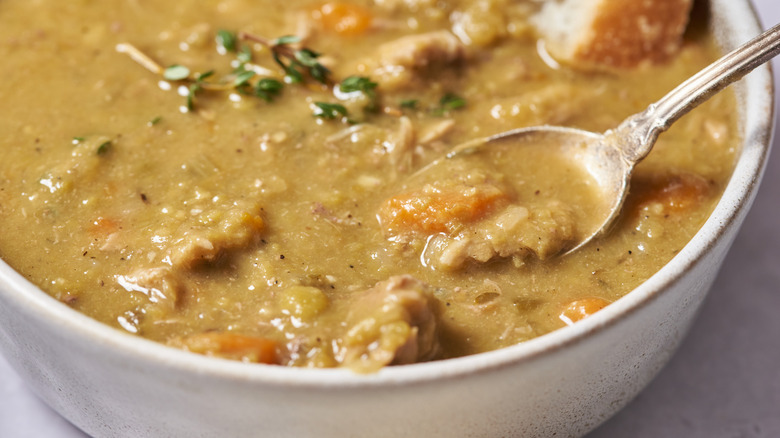
Ingredients
- 1 tablespoon butter
- 1 yellow onion, diced
- 1 cup finely chopped celery
- 3 cloves garlic, minced
- 2 cups green split peas
- 1 pound pork neck bones
- 2 bay leaves
- 2 sprigs thyme
- 1 cup diced carrot
- 6 cups chicken broth or water
- Salt, to taste
- Pepper, to taste
Directions
- Melt butter in a saucepan over medium heat.
- Add the onion, celery, and garlic and saute until softened, about 3–4 minutes.
- Add split peas and pork bones to a slow cooker.
- Add the softened vegetables, bay leaves, thyme, carrots, and broth to the slow cooker.
- Cook on low for 8–9 hours or high for 5–6.
- Remove the thyme sprigs, bay leaves, and pork bones from the slow cooker.
- Shred the pork from the bone and return the meat to the soup.
- Season with salt and pepper to taste, then serve.
Nutrition
| Calories per Serving | 776 |
| Total Fat | 25.6 g |
| Saturated Fat | 8.4 g |
| Trans Fat | 0.0 g |
| Cholesterol | 89.9 mg |
| Total Carbohydrates | 82.3 g |
| Dietary Fiber | 24.4 g |
| Total Sugars | 11.9 g |
| Sodium | 1,553.4 mg |
| Protein | 55.3 g |
